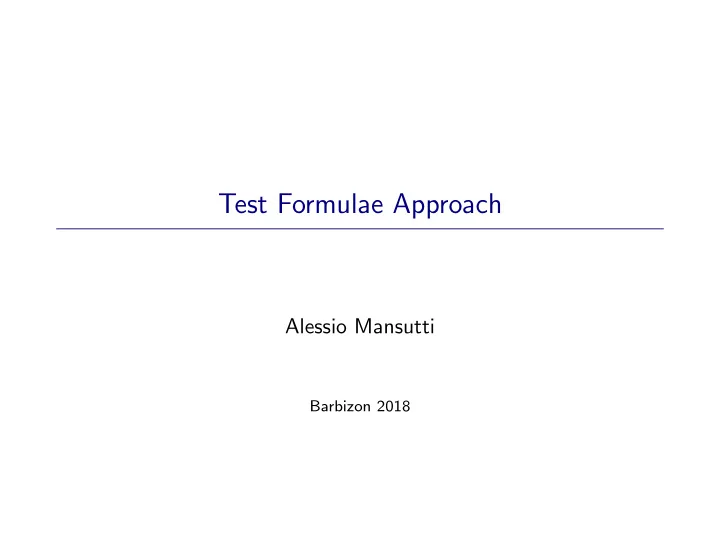

Test Formulae Approach Alessio Mansutti Barbizon 2018
Memory states A memory state is a pair ( s , h ) where: s : VAR → LOC is called store; h : LOC → fin LOC is called heap. where VAR = { x , y , z , . . . } set of (program) variables; LOC set of locations (typically LOC ∼ = N ∼ = VAR ). s ( x ) Generalisation : h could be any finite graph Note: Memory states are the standard model in Separation Logic
Splitting a Heap h 1 : h : h 2 : h = h 1 + h 2 whenever Dom( h 1 ) ∩ Dom( h 2 ) = ∅ ; h is the sum of the two functions h 1 and h 2 .
What we want? To build Test Formulae Fix X ⊆ fin VAR and let n ∈ N ; Test X ( n ) definable finite set of sets of memory states { ( s , h ) | in h there is a path from s ( x ) to s ( y ) } , x , y ∈ X ; { ( s , h ) | h has a loop } . or, equivalently Test X ( n ) finite set of predicates and their semantics. Indistinguishability relation ( s , h ) ≈ n ( s ′ , h ′ ) ⇒ ( s ′ , h ′ ) ∈ T ; holds whenever ∀ T ∈ Test X ( n ), ( s , h ) ∈ T ⇐ Property: for all n , m ∈ N , if m ≥ n then ≈ m ⊆≈ n .
EF-style Game Spoiler chose two structures ( s , h ) and ( s ′ , h ′ ), and n ∈ N resources so that ( s , h ) ≈ n ( s ′ , h ′ ). Then the games continue as follows: If ( s , h ) �≈ n ( s ′ , h ′ ) then Spoiler wins; If ( s , h ) ≈ n ( s ′ , h ′ ) and n = 1 then Duplicator wins; Otherwise, Spoiler choses n 1 , n 2 ∈ N so that n = n 1 + n 2 and two heaps h 1 , h 2 so that h = h 1 + h 2 ; 2 so that h ′ = h ′ Duplicator choses two heaps h ′ 1 , h ′ 1 + h ′ 2 ; Spoiler choses i ∈ { 1 , 2 } . The game continues on the structures ( s , h i ) and ( s ′ , h ′ i ), with n i resources.
EF-style Game Spoiler chose two structures ( s , h ) and ( s ′ , h ′ ), and n ∈ N resources so that ( s , h ) ≈ n ( s ′ , h ′ ). Then the games continue as follows: If ( s , h ) �≈ n ( s ′ , h ′ ) then Spoiler wins; Problem: Given Test X (1), find sufficient conditions on If ( s , h ) ≈ n ( s ′ , h ′ ) and n = 1 then Duplicator wins; Test X ( n ), for all n ∈ N , so that Duplicator has a winning strategy. Otherwise, Spoiler choses n 1 , n 2 ∈ N so that n = n 1 + n 2 and two heaps h 1 , h 2 so that h = h 1 + h 2 ; 2 so that h ′ = h ′ Duplicator choses two heaps h ′ 1 , h ′ 1 + h ′ 2 ; Spoiler choses i ∈ { 1 , 2 } . The game continues on the structures ( s , h i ) and ( s ′ , h ′ i ), with n i resources.
Example: A family that works Given n ∈ N , let # loops ( β ) ≥ β ′ be the set { ( s , h ) | h with at least β ′ loops of size β ≤ n } # loops ↑ ≥ β ′ be the set { ( s , h ) | h with at least β ′ loops of size n + 1 } garbage ≥ β the set { ( s , h ) | in Dom( h ) at least β locations are not part of any loop }
Example: A family that works Given n ∈ N , let # loops ( β ) ≥ β ′ be the set Defining Test X ( n ) as { ( s , h ) | h with at least β ′ loops of size β ≤ n } � β ∈ [1 , n ] # loops ↑ ≥ β ′ be the set # loops ( β ) ≥ β ′ , # loops ↑ ≥ β ′ , � � � � 1 , 1 � β ′ ∈ garbage ≥ β � 2 n ( n + 3) − 1 { ( s , h ) | h with at least β ′ loops of size n + 1 } � � Guarantees a strategy for Duplicator. garbage ≥ β the set { ( s , h ) | in Dom( h ) at least β locations are not part of any loop }
Recommend
More recommend